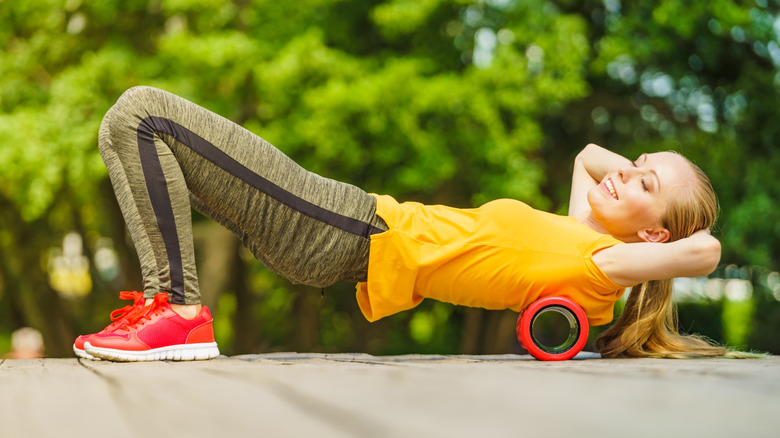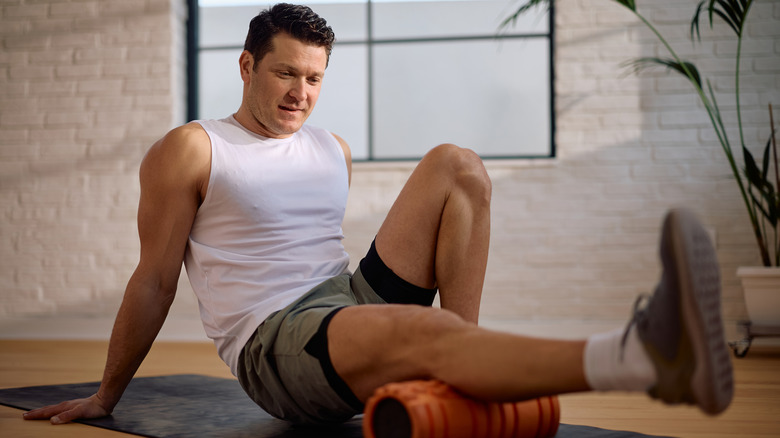Why Hikers And Backpackers Should Be Foam Rolling After Challenging Excursions
Whether you're looking for the best state parks to visit for pristine hiking conditions or attempting to tackle the Appalachian Trail as a first-timer, getting out into nature to enjoy the great outdoors is the perfect way to escape the hustle of everyday life and relax. Hiking and backpacking are fantastic ways to "keep fit and have fun," as the dynamic exercise duo from BodyBreak would say. However, while they are great forms of exercise, recovery after any workout is needed; this is why you should be foam rolling after a challenging excursion. Packing the right type of gear and working on some cardio before heading out on your first, or tenth, excursion are simple steps to help prepare yourself for a long-distance hike; learning how to properly take care of your body after a hike is just as important.
Myofascial pain and muscle tension are forms of annoying muscle discomfort that can create a sharp or burning sensation and tend to linger for a few days after a hike or workout. Ouch! Myofascial pain tends to last the longest in the muscles around your neck, shoulders, lower back, and chest. After carrying a large backpack for hours on end, traversing ever-changing terrain where your spine isn't completely straight, you're constantly straining your muscles. This is why you may feel that sudden relief as soon as you remove the pack, literally lifting the weight off of your shoulders.
Why muscle pain persists after hiking and how foam rolling can fix it
Muscle tension and myofascial pain can rear their ugly heads on anyone, from professional athletes who spend hours a day training to amateur backpackers hitting a trail for the first time. Your muscles develop microscopic damage after unaccustomed or strenuous activity, and your body responds by bringing nutrient-rich fluid and immune and repair cells to the area to rebuild stronger muscle fibers. Delayed Onset Muscle Soreness (DOMS) is that sore and uncomfortable feeling you get 12 to 48 hours after a workout or hike. Foam rolling can help ease tension around painful knots (known as "trigger points"), improve circulation, and reduce discomfort after a hike.
In an Expert Advice blog post on REI's website, Ken Knapp spoke to Tim Bird, an Appalachian Trail hiker and Sales Manager at the REI store in Knoxville, to pick his brain on the best way to recover after a strenuous hike. Tim mentions that while using a foam roller to massage sore areas on a hike isn't common, using a hiking pole or hard-sided water bottle to slowly massage sore leg muscles is a great way to treat your body after a hike.
Slowly rolling a foam roller (about an inch every second) over a sore muscle group for about 10 to 15 minutes after a hike is the best way to increase blood flow to your muscles to speed up the recovery process. Keep in mind, using a foam roller can feel uncomfortable and painful at first, especially on those tender trigger points. When you feel the tender area, you'll want to hold the position for about 20 to 30 seconds and repeat it about ten times.
Other ways to recover smarter and faster after a day outdoors
After any strenuous workout, seasoned hikers, backpackers, and even bodybuilders will tell you that muscle recovery is perhaps more important to building muscle growth than the act of actually exercising. Overtraining any muscle group, whether it be resistance training or strenuous hiking, can cause decreased performance or serious injuries.
Taking the time to do some mild stretching before setting out on a hike decreases injury just as much as incorporating a cool-down period after a hike can increase recovery by preventing fluid from settling around your muscles and joints. Don't overdo it on the trails either. Listen to your body at the first sign of pain or discomfort, and pack light in order to ease strain on your shoulders and back.
Also, if you've stepped into a gym and have seen someone carrying around a larger-than-life Stanley water bottle, there's a good reason for that. Hydration is a key element to not only quenching your thirst but also for proper muscle recovery. Drinking water while you sweat, hike, bike, or lift replaces important fluids and electrolytes in your body to ensure muscle function and allow the fascia tissues surrounding your muscles to heal. That way, you can spend less time in pain and more time planning your next outdoor adventure.


